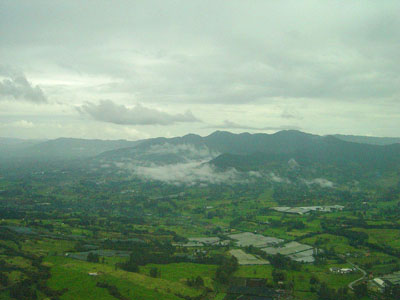|
Along South America west coast is the world’s longest mountain range, the Andes, winding for more than 7000 miles, the Andes start at the north of South America in Venezuela and extend southward to the tip of Chile. Made up of some of the highest peaks in the world, the Andes with more than 50 mountain peaks reaching above 20,000 feet are only surpassed in height by Asia’s Himalayas.
The Andes traverse the continent of South America north to south through seven countries often called the Andean States: Venezuela, Colombia, Ecuador, Peru, Bolivia, Argentina and Chile. The Andes are made up of two main ranges, the Cordillera Occidental and the Cordillera Oriental. Expanding to a width of 390 miles in Bolivia the Andes two main ranges have an average width of 200 miles and are separated by deep depressions and plateaus. Several parts of South America are pocketed with smaller chains, yet just as important in the makeup of the Andes.
Aconcagua, the Andes highest peak at 22,841 feet is located in Argentines Andean Mendoza region. Mount Chimborazo, a dormant volcano in the Ecuadorian Andes, reaches to a height of 20,565 feet, not one of the world’s highest peaks, Mount Chimborazazo summit is the farthest point from the earth’s core at 3,968 miles.
Aruba, Bonaire, and Curacao, Caribbean Islands located off the northern shore of South America and the country of Venezuela make up the northernmost part of the Andes mountain range. The Andes are often divided into three regions. To the north the Andes are made up of the Cordillera Oriental and Cordillera Occidental running through northern Ecuador, Colombia and Venezuela. In Colombia the Andes add the Central Cordillera, a third mountain range. The Central Andes take in the countries of Peru and Bolivia. The Bolivian Andes rise to a height of 21,463 feet with the mountain peak of Nevado Sajama, to the west the Altiplano region of the Bolivian Andes contain Lake Titicaca and the world’s largest salt flats, Salar de Uyuni. The Southern Andes located in Chile and Argentina bend eastward as they reach the tip of South America.
The climate of the Andes, depending on the altitude, the latitude along with the closeness to the Pacific Ocean and the Caribbean will vary drastically. In the northern Andes, the climate is rainy and warm, average temperatures in Colombia will be steady around 68 degrees, yet the weather is known to change greatly. The Central Andes are cool and dry as they are affected mainly by the cool waters of the Pacific flowing north. The southern Andes climate are typically cool and wet while receiving moist air coming off the southern Pacific Ocean.
The height of the Andes has a great effect on the weather in surrounding areas, Ecuador has rainforest in view of snow covered mountains and volcanoes. While the central Andes in Peru and northern Chile has the world’s driest desert, the Atacama. The permanent snow line varies greatly in the location of the Andes as they wind their way through South America. In the Northern Andes the snow line will be found at altitudes starting around 14,500 to 15,500 feet. Moving down the chain, the snow line will rise in the Peruvian Andes to northern Chile to an altitude around 15,000 to 17,000 feet. In Chile the southern Andes snow line will start around 14,700 feet yet as moving farther south along the chain where in Argentina’s Tierra de Fuego the snow line and glaciers will almost reach sea level.
|